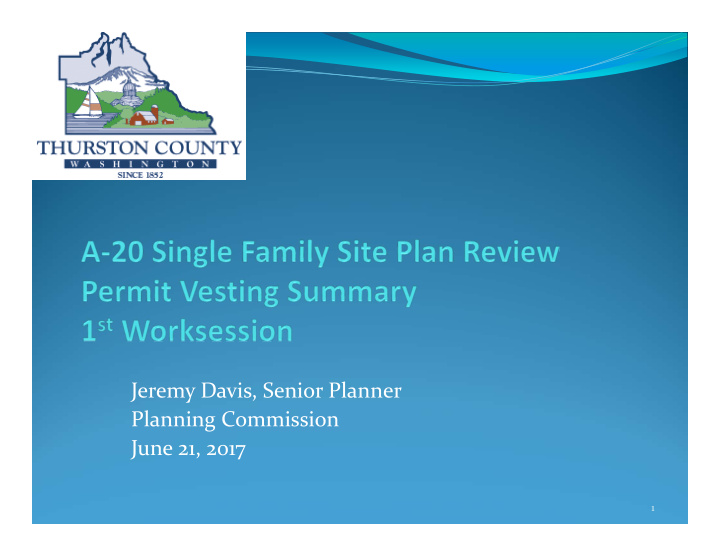



Jeremy Davis, Senior Planner Planning Commission June 21, 2017 1
This Worksession: The Issues What is Vesting in a Nutshell? Vesting Approaches Vesting in the 50’s, 60’s, 70’s and 80’s 1987 – The big change Vesting in the 90’s, 00’s and beyond What Regulations Vest? County CSA Process Introduction 2
Issues Recent case law has changed which projects are vested under state law. Previous to this court decision, common law vesting applied to some but not all permits. Local jurisdictions are permitted to allow permit vesting. The County’s Single Family Conditional Site Approval process was found to no longer vest. 3
Vesting – A Nutshell Establishment of legal rights for a property owner to use a property that cannot be changed Typically associated with an application date, specific date or time period, or investment in improvements Intent is to provided certainty and fairness by “freezing” the applicable laws Permit applied for complies with existing codes and regulations Legislative decisions such as comprehensive plan amendments and rezones do not vest 4
Vesting Approaches Majority Approach: When Substantial Development Takes Place Movable date dependent on investments Washington State: The day a complete application is filed “Date certain” approach 5
Fairness/Certainty rationale Vesting goes with each permit Complete Permit Application Decision Freeze the Applicable Law Washington’s Vested Rights Doctrine; How We Have Muddled a Simple Concept and How We Can Reclaim It, Wynne, 2001 6
The 50’s and 60’s Vesting occurs with a complete building permit application (Hull v. Hunt, 1958) In 1968 the Supreme Court extended it to conditional use permits (Beach v. Board of Snohomish County, 1968) 7
The 70’s Court of Appeals extends vesting to grading permit applications and shoreline substantial development permit applications (Juanita Bay Valley Community Association v. City of Kirkland, 1973) Court of appeals extends the doctrine to complete septic tank permit applications (Ford v. Bellingham ‐ Whatcom County Dist. Bd. of Health, 1977) 8
The 80’s ‐ Appeals did not extend rights to preliminary site plan applications Municipalities may develop local vesting rules consistent with state and case law Pre ‐ application procedures cannot give an unfettered ability to change the rules (West Main Assoc. v Bellevue, 1986) 9
1987 – A big year Supreme Court held vesting did not apply to binding site plans (Valley View Industrial Park v. City of Redmond, 1987) State law changed to apply vested rights to building permits, preliminary subdivision applications, but not to preliminary or binding site plans 10
The 90’s Land use applications to be considered only under the land use statures and ordinances in effect at the time of application. (Noble Manor v. Pierce County, 1997) Washington approach to vesting is explained further – “constitutional principles of fairness and due process” (Weyerhaeuser v. Pierce County, 1999) A nonconforming use does not terminate just because the zoning laws change (Rhod ‐ A ‐ Zalea v. Snohomish County, 1998) Short plat applications vest for land use and zoning laws (Nobel Manor v. Pierce County, 1997) Vesting survives annexation (Schneider Homes v. City of Kent, 1998) 11
The 2000’s Vested rights are not waivable and there are no selective benefits (Appeals: East County Reclamation Co. v. Bjornsen, 2005) Building permits that contain knowing misrepresentations do not vest (East County Reclamation Co. v. Bjornsen, 2005) Site plan review does not vest, need a building permit (Abbey Rd. Group, LLC v. City of Bonney Lake, 2009 & Erickson & Associates, Inc. v. McLerran, 1994) Site plan reviews that are a prerequisite to a vested permit do vest (Deer Creek Developers, LLC v. Spokane County, 2010) Application that is not consistent with the comp plan does not vest (Kelly v. Chelan County, 2010) 12
10’s – The New Big Decisions Vested rights statutory, the common law vested rights doctrine goes away* (Appeals: Potala Village Kirkland, LLC, v. City of Kirkland, 2014 & Supreme Court: Town of Woodway v. Snohomish County) Permits do not vest for NPDES, State Issued Permits Land use control ordinances mean only those ordinances adopted as a matter of local discretion, not implementing a state mandate (Supreme Court: Snohomish County v. Pollution Control Hearings Board, 2016) 13
What types of regulations vest? Subdivisions (RCW 58.17.033) Local land use control ordinances Other standards as permitted by law Building Permits (RCW 19.27.095) Building and Associated Construction Codes Land use control ordinances Development Agreements (36.70B.180) Land use control ordinances Other standards agreed to in the development agreement 14
What is a Land Use Control Ordinance Zoning Critical areas regulations* Procedural rules Does not include: Health and Safety Regulations (Building codes, Fire codes) NPDES Stormwater Regulations (Snohomish County v. Pollution Control Hearings Board, 2016) Impact fees (New Castle Invs. V. City of La Center, 1999) Connection and other fees (Lincoln Shiloh Assoc. Ltd. v. Mukilteo Water Dist., 1986) Certain procedural rules for setting plat expiration dates (Graham Neighborhood Assoc. v. F.G. Associates, 2011) 15
County CSA Process Intro County Conditional Site Approval CSA Process in use since mid 1990’s Process used to complete zoning ordinance and critical areas review for single family proposals County allowed permits to vest prior to the Fall of 2015 In the fall of 2015, County reviewed vesting issue It was determined that the CSA needed to be added to the code in order to allow vesting since septic take permits no longer vested projects 16
Residential CSA Intent is to allow for a single family home site plan review process Site plan review process will allow applicants to vest under current county code Vesting allows for appropriate site planning without worrying about changes in land use control ordinances CSA will not vest for building and other technical codes unless an concurrent applicant submits a complete building permit application 17
Next Steps: Staff Draft of Proposed Changes 2 nd Planning Commission Briefing Further Briefings (if needed) Set Public Hearing Hold Public Hearing Review Public Comments Recommendation to Board of County Commissioners 18
19
Recommend
More recommend